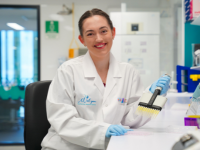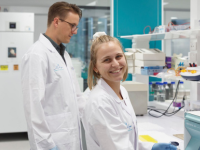This September respiratory experts from across the world will be brought together to showcase all the latest advances in respiratory medicine and science.
Taking place from 9 – 13 September in Milan, Italy, the European Respiratory Society (ERS) International Congress offers a comprehensive programme covering a range of diseases areas including sleep and breathing disorders, airway diseases, paediatric respiratory diseases, and respiratory infections.
The Wal-yan Respiratory Research Centre is proud to have a team of researchers taking part in, and contributing to, the outstanding scientific programme of the Congress.
A snapshot of some of the Wal-yan researchers and their Congress presentations include:
Associate Professor Shannon Simpson

Presentation 1: PELICAN Clinical Research Collaboration
As Co-Chair of PELICAN (Prematurity’s Effects on the Lungs In Children and Adults Network), Associate Professor Simpson will be hosting PELICAN meetings and presenting on the PELICAN Clinical Research Collaboration (CRC).
The PELICAN CRC was launched by the ERS in 2020. Although enhanced perinatal care has markedly improved survival outcomes for all preterm infants, there is clear evidence of poorer lung health outcomes in this population. PELICAN has the overarching objective to harmonise cross-sectional and longitudinal datasets globally, to describe the impact of preterm birth on lung health trajectories over its life course, and to determine which neonatal and lifetime exposures contribute to the progression of lung disease in this vulnerable population.
Presentation 2: Developing a Priority Setting Partnership for Preterm Lung Health (on behalf of PELICAN CRC)
About the research:
It is essential to embed consumer perspectives into the research journey, including setting the future research agenda. Priority Setting Partnerships (PSP) are a well-established consumer involvement tool. The clear evidence gaps in prematurity associated lung disease and the increased awareness of intentionally involving and empowering consumers has provided us with a timely opportunity to identify and understand what the community sees as most important. We aimed to determine the ‘Top 10’ research priorities for preterm lung health by undertaking a PSP with the end users of research – family members and those who care for people born preterm, preterm born individuals, and health professionals with an interest in the lung health of people born prematurely.
Dr Elizabeth Smith

Presentation: Early-life risk-factors determine distinct lung function trajectories for those born preterm
About the study:
Whilst people born early are more likely to develop respiratory disease, it is difficult to predict which individuals will be most affected. We aimed to determine the different 'trajectories' or paths that lung function can take following preterm birth, and what are the risks for following the path that leads to worse adult lung function. To do this, we collected lung function data from 200 people born early (less than 32 weeks gestation) in Perth, between ages 5 and 19. We found that individuals who were admitted to hospital for a respiratory infection in childhood were four times more likely to follow the lower lung function trajectory. Those exposed to tobacco smoke at home were twice as likely to follow this poorer trajectory. Understanding these risks can help healthcare professionals provide the best information to families, and help direct research to improve outcomes for these children.
Tiffany Bradshaw

Presentation: Prematurity-associated lung disease is frequently mis-diagnosed as asthma
About the study:
Many people born preterm have life-long deficits in their lung health, which may be progressive over the lifespan. These individuals also experience ongoing respiratory symptoms, which is often diagnosed as asthma. Whether prematurity-associated lung disease is asthma is subject to intense debate. 234 children and adolescents born very preterm (<32 weeks gestation) underwent lung function testing and completed respiratory health questionnaires. We used the recent ERS clinical practice guidelines for the diagnosis of asthma in children, to determine the rates of asthma in our cohort. This study found there were very few individuals that had been previously diagnosed by a doctor with asthma, that also met the ERS asthma diagnostic criteria. We also found that many individuals born preterm have lung health deficits and respiratory symptoms, but do not meet the asthma diagnostic criteria. Our study helps clinicians understand the similarities and differences between preterm lung disease and typical childhood asthma.
Denby Evans

Presentation 1: Investigating the relationship between inflammatory biomarkers and lung function in survivors of very preterm birth
Presentation 2: Characterisation of airway epithelial cells from survivors of very preterm birth at one year of age
About the research:
Denby is presenting on two projects, both of which focus on the lungs of babies and children who are born early, called preterm birth. The first project looked at markers of inflammation in the urine and exhaled breath of children and young adults born preterm. The study aimed to see if higher levels of inflammation were related to poor lung function. The project saw some urinary inflammatory markers were increased in children born early, however this was not directly related to lung function. Inflammation in exhaled breath was too low to be detected using standard laboratory techniques, so more work is still needed to understand how inflammation in the lungs might affect lung function.
The second project collected airway cell samples from one-year old babies that were born preterm. The airway cells were studied in the laboratory, which found that the cells were more difficult to grow and were more leaky than airway cells collected from babies born on time. Leaky airway cells can be bad for the lungs, as it can cause damage to the airway and makes it easier to get infections with germs and viruses. By finding these problems in the airway cells, we can now start trying to find ways to make the cells stronger and help improve lung function in those born early.
Samantha McLean

Presentation: Azithromycin improves wound repair but does not change permeability of preterm airway epithelial cells
About the study:
Our team’s work aims to improve lung function in those who are born too early, known as preterm birth. Breathing in the early days and months is tough for the preterm baby, additionally, evidence suggests that lung function gets worse throughout childhood. This means that the damage to the lungs is ongoing and needs treatment. Azithromycin, traditionally used as an antibiotic, has shown improvements in other lung conditions such as asthma and is a possible treatment for ongoing preterm lung disease. This study aims to collect the missing laboratory evidence to help us understand if azithromycin will have beneficial effects in people born preterm. Cells that line the airways (airway epithelial cells) were used to investigate the useful effects of azithromycin. We found that azithromycin improved wound repair but did not improve the leakiness of preterm airway epithelial cells. These findings show the benefits azithromycin had on preterm airway epithelial cells and that more research into azithromycin is needed for survivors of preterm birth. Finding a treatment for preterm lung disease will help our smallest babies live their biggest lives.
Dr Samuel Montgomery

Presentation 1: Post hoc analysis of a phase 3, cluster randomised clinical trial of peginterferon beta-1a to reduce transmission of SARS-CoV-2: effect of viral load on transmission and risk factors for hospitalisation
About the study:
This study is a statistical analysis of data from ConCorD-19 looking at risk factors for hospitalisation in the study. ConCorD-19 was an international trial which demonstrated that the drug interferon could help reduce the spread of COVID-19 from a positive person to their household contacts.
Presentation 2: Optimisation of DNA extraction from nasal lining fluid to assess the nasal microbiome
About the study:
The nose is the site of “first contact” for pathogens such as viruses and bacteria, however the community of bacteria that live in your nose, or “microbiome”, may play a role in protecting people from disease. Sampling the nose to measure inflammation and determine what is present in your microbiome often uses a saline wash of the nasal cavity, or a nasal swab (similar to a rapid antigen test) respectively. A newer sampling technique called “nasosorption”, where the fluid lining your airway is absorbed, is minimally invasive and well tolerated but the feasibility of assessing the nasal microbiome using these samples is unknown. This study aimed to optimise DNA extraction from nasal lining fluid and determine microbial community profiles. From this study, we were able to successfully extract DNA and identify the bacteria that make up the microbiome in the nose.
The Wal-yan Respiratory Research Centre – a powerhouse partnership between The Kids Research Institute Australia, Perth Children’s Hospital Foundation and Perth Children’s Hospital – has a vision to ensure that all children have healthy lungs for life.
The Centre is proud of our team’s research, which brings us closer to this vision every day.
